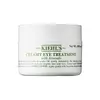What's inside
What's inside
 Key Ingredients
Key Ingredients

 Benefits
Benefits

 Concerns
Concerns

 Ingredients Side-by-side
Ingredients Side-by-side

Water
Skin ConditioningCaprylic/Capric Triglyceride
MaskingButyrospermum Parkii Butter
Skin ConditioningGlycerin
HumectantCandelilla/Jojoba/Rice Bran Polyglyceryl-3 Esters
EmulsifyingDimethicone
EmollientIsododecane
EmollientAcetyl Ethylhexyl Polyhydroxystearate
EmollientGlyceryl Stearate
EmollientHydrogenated Polydecene
EmollientStearyl Alcohol
EmollientButylene Glycol
HumectantCetearyl Alcohol
EmollientPhytonadione Epoxide
AstringentSimmondsia Chinensis Seed Oil
EmollientPhospholipids
Skin ConditioningMelia Azadirachta Flower Extract
Skin ConditioningOryza Sativa Bran Extract
Skin ConditioningOcimum Sanctum Leaf Extract
Skin ConditioningSorbitan Oleate
EmulsifyingMelia Azadirachta Leaf Extract
Skin ConditioningAlgin
MaskingAloe Barbadensis Leaf Juice Powder
Skin ConditioningCellulose
AbsorbentSodium Phytate
Escin
TonicLeuconostoc/Radish Root Ferment Filtrate
AntimicrobialCurcuma Longa Root Extract
MaskingOcimum Basilicum Flower/Leaf Extract
TonicCorallina Officinalis Extract
Skin ConditioningRuscus Aculeatus Root Extract
AstringentAmmonium Glycyrrhizate
MaskingHelianthus Annuus Extract
EmollientCentella Asiatica Extract
CleansingHydrolyzed Yeast Protein
Skin ConditioningCalendula Officinalis Flower Extract
MaskingRosmarinus Officinalis Leaf Extract
AntimicrobialTocopherol
AntioxidantIsopropyl Titanium Triisostearate
EmollientPanthenol
Skin ConditioningCaprylyl/Capryl Glucoside
CleansingSodium Stearoyl Lactylate
EmulsifyingAmmonium Acryloyldimethyltaurate/Vp Copolymer
Microcrystalline Cellulose
AbsorbentSodium Acrylate/Sodium Acryloyldimethyl Taurate Copolymer
Emulsion StabilisingHdi/Trimethylol Hexyllactone Crosspolymer
Dimethicone Crosspolymer
Emulsion StabilisingHydroxyacetophenone
AntioxidantPolyisobutene
Polymethylsilsesquioxane
Cetyl Alcohol
EmollientCitric Acid
BufferingSodium Citrate
BufferingMica
Cosmetic ColorantTin Oxide
AbrasivePhenoxyethanol
PreservativeCI 77891
Cosmetic ColorantCI 77491
Cosmetic ColorantWater, Caprylic/Capric Triglyceride, Butyrospermum Parkii Butter, Glycerin, Candelilla/Jojoba/Rice Bran Polyglyceryl-3 Esters, Dimethicone, Isododecane, Acetyl Ethylhexyl Polyhydroxystearate, Glyceryl Stearate, Hydrogenated Polydecene, Stearyl Alcohol, Butylene Glycol, Cetearyl Alcohol, Phytonadione Epoxide, Simmondsia Chinensis Seed Oil, Phospholipids, Melia Azadirachta Flower Extract, Oryza Sativa Bran Extract, Ocimum Sanctum Leaf Extract, Sorbitan Oleate, Melia Azadirachta Leaf Extract, Algin, Aloe Barbadensis Leaf Juice Powder, Cellulose, Sodium Phytate, Escin, Leuconostoc/Radish Root Ferment Filtrate, Curcuma Longa Root Extract, Ocimum Basilicum Flower/Leaf Extract, Corallina Officinalis Extract, Ruscus Aculeatus Root Extract, Ammonium Glycyrrhizate, Helianthus Annuus Extract, Centella Asiatica Extract, Hydrolyzed Yeast Protein, Calendula Officinalis Flower Extract, Rosmarinus Officinalis Leaf Extract, Tocopherol, Isopropyl Titanium Triisostearate, Panthenol, Caprylyl/Capryl Glucoside, Sodium Stearoyl Lactylate, Ammonium Acryloyldimethyltaurate/Vp Copolymer, Microcrystalline Cellulose, Sodium Acrylate/Sodium Acryloyldimethyl Taurate Copolymer, Hdi/Trimethylol Hexyllactone Crosspolymer, Dimethicone Crosspolymer, Hydroxyacetophenone, Polyisobutene, Polymethylsilsesquioxane, Cetyl Alcohol, Citric Acid, Sodium Citrate, Mica, Tin Oxide, Phenoxyethanol, CI 77891, CI 77491
Water
Skin ConditioningButyrospermum Parkii Butter
Skin ConditioningButylene Glycol
HumectantTridecyl Stearate
EmollientPEG-30 Dipolyhydroxystearate
EmulsifyingIsodecyl Salicylate
Skin ConditioningTridecyl Trimellitate
EmollientPersea Gratissima Oil
Skin ConditioningIsocetyl Stearoyl Stearate
EmollientPropylene Glycol
HumectantDipentaerythrityl Hexacaprylate/Hexacaprate
EmulsifyingSorbitan Sesquioleate
EmulsifyingMagnesium Sulfate
Hydrogenated Castor Oil
EmollientSodium PCA
HumectantPhenoxyethanol
PreservativeChlorphenesin
AntimicrobialHydrogenated Jojoba Oil
AbrasiveP-Anisic Acid
MaskingTocopheryl Acetate
AntioxidantIsopropyl Palmitate
EmollientDisodium EDTA
Copper PCA
HumectantHelianthus Annuus Seed Oil
EmollientCI 40800
Cosmetic ColorantCitric Acid
BufferingWater, Butyrospermum Parkii Butter, Butylene Glycol, Tridecyl Stearate, PEG-30 Dipolyhydroxystearate, Isodecyl Salicylate, Tridecyl Trimellitate, Persea Gratissima Oil, Isocetyl Stearoyl Stearate, Propylene Glycol, Dipentaerythrityl Hexacaprylate/Hexacaprate, Sorbitan Sesquioleate, Magnesium Sulfate, Hydrogenated Castor Oil, Sodium PCA, Phenoxyethanol, Chlorphenesin, Hydrogenated Jojoba Oil, P-Anisic Acid, Tocopheryl Acetate, Isopropyl Palmitate, Disodium EDTA, Copper PCA, Helianthus Annuus Seed Oil, CI 40800, Citric Acid
 Reviews
Reviews

Ingredients Explained
These ingredients are found in both products.
Ingredients higher up in an ingredient list are typically present in a larger amount.
Butylene Glycol (or BG) is used within cosmetic products for a few different reasons:
Overall, Butylene Glycol is a safe and well-rounded ingredient that works well with other ingredients.
Though this ingredient works well with most skin types, some people with sensitive skin may experience a reaction such as allergic rashes, closed comedones, or itchiness.
Learn more about Butylene GlycolThis ingredient is also known as shea butter. It is an effective skin hydrator and emollient.
Emollients help soothe and soften your skin. It does this by creating a protective film on your skin. This barrier helps trap moisture and keeps your skin hydrated. Emollients may be effective at treating dry or itchy skin.
Shea butter is rich in antioxidants. Antioxidants help fight free-radicals, or molecules that may harm the body. It is also full of fatty acids including stearic acid and linoleic acid. These acids help replenish the skin and keep skin moisturized.
While Shea Butter has an SPF rating of about 3-4, it is not a sunscreen replacement.
Shea butter may not be fungal acne safe. We recommend speaking with a professional if you have any concerns.
Learn more about Butyrospermum Parkii ButterCitric Acid is an alpha hydroxy acid (AHA) naturally found in citrus fruits like oranges, lemons, and limes.
Like other AHAs, citric acid can exfoliate skin by breaking down the bonds that hold dead skin cells together. This helps reveal smoother and brighter skin underneath.
However, this exfoliating effect only happens at high concentrations (20%) which can be hard to find in cosmetic products.
Due to this, citric acid is usually included in small amounts as a pH adjuster. This helps keep products slightly more acidic and compatible with skin's natural pH.
In skincare formulas, citric acid can:
While it can provide some skin benefits, research shows lactic acid and glycolic acid are generally more effective and less irritating exfoliants.
Most citric acid used in skincare today is made by fermenting sugars (usually from molasses). This synthetic version is identical to the natural citrus form but easier to stabilize and use in formulations.
Read more about some other popular AHA's here:
Learn more about Citric AcidPhenoxyethanol is a preservative that has germicide, antimicrobial, and aromatic properties. Studies show that phenoxyethanol can prevent microbial growth. By itself, it has a scent that is similar to that of a rose.
It's often used in formulations along with Caprylyl Glycol to preserve the shelf life of products.
Water. It's the most common cosmetic ingredient of all. You'll usually see it at the top of ingredient lists, meaning that it makes up the largest part of the product.
So why is it so popular? Water most often acts as a solvent - this means that it helps dissolve other ingredients into the formulation.
You'll also recognize water as that liquid we all need to stay alive. If you see this, drink a glass of water. Stay hydrated!
Learn more about Water